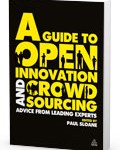Jul05
Andrea Meyer
Point: Crowdsourcing and open innovation efforts rely on participation. Attracting participants and encouraging activity is a key success factor in obtaining and vetting new product, service and process innovation ideas.
Story: Crowdsourcing is only as good as the crowd. Presenters at the World Research Group‘s Innovation Cubed Summit described several methods that they use to engage people for internal innovation efforts. In particular, they talked about getting participation beyond just idea submission.
Although some innovation contests have an easy-to-score objective measure of success (such as NetFlix’s rating algorithm contest or the get-to-space Ansari X PRIZE), most participatory innovation efforts cast a wider net and have more open-ended, subjective measures of performance. That means people need to evaluate all the submissions to find the best ones. These broad innovation contests involve more than just submitting a great idea (the proverbial 1% inspiration). The effort also requires the 99% perspiration to sort through hundreds or thousands of candidate ideas, score those ideas, and refine the ideas. Motorola, for example, received 17,000 ideas in their system. How can companies evaluate ideas?
The solution is to recruit and reward a crowd that helps curate, moderate, vote, and refine ideas even if those participants aren’t idea submitters. Kraft and PepsiCo, for example, emphasized ease-of-use in their efforts at increasing participation. They make it very simple and intuitive to join the innovation effort, submit ideas, vote, comment, and participate in the effort. The companies avoid the temptation of asking too many questions and putting approvals barriers on participation.
Real-time recognition also spurs interest and activity. Both PepsiCo and Motorola post a leaderboard of “Who’s Hot” on their innovation portals. The up-to-date ranking list enables competitive participants to see their standing at any time. Timely updates to standings keep people more engaged than if the company ran a “submit-by-the-deadline-and-you won’t-hear-anything-for-a-month” black hole contest. Game mechanics with well-defined ways of earning points or game currency help increase activity.
Finally, offer a sliding scale of rewards for valuable participation, not just idea submission. Although some contests focus on rewarding a single big winner with the best idea, several of the companies at the summit sought ways to reward more of the participants in the system. For example, PepsiCo offers participatory awards for reaching certain point totals. Both Motorola and PepsiCo had side-contests for high levels of participation, such as “Top Voter” or “Top Point-Getter” in addition to awards for the best ideas. Approximately 10% of PepsiCo’s 3000 participants reached some sort of award level for their participation in the open innovation efforts.
Action
- Minimize the labor, barriers, or hassles for participation in innovation efforts
- Create a transparent process with clearly-defined expectations and rewards for participation as well as idea submission
- Provide a sliding scale of rewards for all kinds of participation on the innovation process, not just one big prize for one big idea.
For further information: The next World Research Group Open Innovation Summit will be held August 10-12, 2011 in Chicago, IL.
Case study, Innovation, open innovation
Jun08
Andrea Meyer
Point: Open innovation is much more cost-effective than internal R&D
Story: Larry Huston, formerly Innovation Officer at Procter & Gamble, spoke at the World Innovation Forum on June 8, 2011. Huston praised open innovation as a way for big companies to speed their innovation and time to market. Huston said that open innovation efforts give companies a 2x return compared to developing the innovation in-house because of risk reduction. The reason, Huston said, is  simple: the technology is already proven to work; it just needs to be scaled or adapted. In short, with open innovation a new technology has a much lower risk of failure than starting internal R&D from scratch. Also, given the realities of corporate life, internal R&D people aren’t just doing innovation all the time — they have administrative work and meetings — which means that internal innovation is much less efficient than open innovation.
simple: the technology is already proven to work; it just needs to be scaled or adapted. In short, with open innovation a new technology has a much lower risk of failure than starting internal R&D from scratch. Also, given the realities of corporate life, internal R&D people aren’t just doing innovation all the time — they have administrative work and meetings — which means that internal innovation is much less efficient than open innovation.
Huston related the story of an internal P&G employee who had the idea of printing text and designs on Pringles potato chips — designs like Disney characters or trivia questions. The employee made a very thin potato dough and ran it through an HP printer to demonstrate the idea. But P&G needed edible food dyes that wouldn’t clog the printer or a printing technology that could handle edible food dyes.
So P&G approached a big printer manufacturer to work together with P&G to come up with a way to print on potato chips. The two big companies spent a year in meetings trying to hammer out the intellectual property (IP) rights issue. The printer company wanted all the IP, even though the two companies would be developing it together. P&G even offered to give the partner the patents if P&G could own only the one application of printing on potato chips. If the partner company then wanted to sell the technology to McDonald’s to print on hamburgers, they could. But still the other company did not agree to those IP terms.
Exasperated by the slow pace of the negotiations, P&G wrote a public brief describing the technical problem to be solved and sent it out worldwide. An innovation network in Europe picked it up, and the brief landed on the desk of a professor in Bologna. The professor, as it turns out, had inherited a bakery. He had dabbled with the equipment and created and edible food dye that could be printed on cakes and cookies. P&G licensed the IP from him and launched Pringles Prints in eight months, compared to spending one year just discussing IP with the large company. Within one year, the new product grew P&G’s revenues 14% — a very impressive result given the size of P&G.
Publicizing its R&D needs was a big change for P&G. In the past, P&G kept its R&D efforts closely guarded. “We were afraid to share our technology needs,” Huston said. “We thought competitors would read our briefs and launch their product first. But not once did that happen, out of hundreds of briefs” The reality, Huston said, was “Companies work on what they think the problems are. Reading a brief, they don’t see the end product, and they’re not likely to reorient their efforts as a result. Once they see the product in the market, then they’ll respond.” Instead, Huston advocated, “let the world know what you want and that your door is open to ideas from the outside.” In response to a question from the audience, Huston elaborated: “Half of our briefs have our name on them, and those get many more responses. Other briefs do not have our name.” Those briefs couch the request in more scientific terms, solving the underlying problem rather than explaining the consumer product application.
Action:
- Don’t be afraid to advertise your R&D needs in order to attract outside innovators. Competitors are unlikely to reorient their own thinking to follow you.
- If you’re still concerned about competitors taking your nascent idea, don’t put your company name on the brief, and phrase it in terms of the underlying science to be solved
- Look for smaller, nimble open innovation partners with early-stage prototype technologies.
- Innovate faster by leveraging proven technologies created by third parties.
- Focus on lower-risk adaptation and scaling of existing external technologies rather than high-risk creation and scaling of unknown internal technologies.
For more information: World Innovation Forum
Case study, Growth, How-to, Innovation, New Product Development, open innovation
Apr15
Andrea Meyer
Point: Use open innovation and modularity to identify new product/service needs and accelerate your pace of innovation
Story: Rugged handheld computers are used every day by retailers,warehouse operators, service technicians, parcel companies, and transportation operators to log customer purchases, track inventory, monitor shipments, and scan tickets. Half a dozen manufacturers compete in the crowded market for these devices to serve customers who want everything — devices that are hardy, high-tech, compact, inexpensive, and suited to their particular needs.
retailers,warehouse operators, service technicians, parcel companies, and transportation operators to log customer purchases, track inventory, monitor shipments, and scan tickets. Half a dozen manufacturers compete in the crowded market for these devices to serve customers who want everything — devices that are hardy, high-tech, compact, inexpensive, and suited to their particular needs.
PsionTeklogix needed to differentiate itself from competitors like Motorola, Intermec, Datalogic, Honeywell, and LXE. The company created a modular platform strategy called Omnii with interchangeable keyboards, scanners, communications modules, screens, grips and optional features like a camera and GPS. Rather than build small volumes of unique devices for each application or new technology, Psion created a modular platform to build components in cost-effective volumes and then mix-and-match the parts to create a custom-built assembly.
For example, Psion or one of its partners can create a new RF communications module (e.g., for a new cellular data standard) and then plug that module into many of the pre-existing Omnii products. This strategy accelerates innovation because it’s faster and cheaper to design a new module than to redesign an entire product. This strategy also accelerates adoption of innovation by customers because customers don’t have to replace all their handheld computers, only swap in the new modules.
Then, Psion went a step further, introducing its Open Source Mobility initiative. Psion created IngenuityWorking.com, an open, collaborative online community for Psion employees, developers, partners and customers. The goals are twofold:
- to leverage Psion’s large IP portfolio with a wide range of vendors and component suppliers
- to give customers and resellers the ability to voice needs and identify micro-niches in the market.
In summary:
- PSION uses its IngenuityWorking.com site with customers, developers and partners to drive product developments
- Psion leverages its strengths (modularity & customization) to reduce waste, improve time to market and gain new commercial options
Action:
- Create product/service architectures than enable fast insertion of new technologies. In Psion’s case, interchangeable displays, user interfaces, scanners, radios, etc. all combine to provide a myriad of combinations of functionality inside the rugged case.
- Create an online community among your partners and customers to learn their needs and identify new product/service opportunities.
- Populate the OI site with technical information that helps partners contribute practical and compatible innovations
- Allow customer complaints on the site (valid complaints, not offensive vitriolic rants). This transparency builds trust over time as customers and partners see how you address problems.
For more information, see Todd Boone of PsionTeklogix’s chapter in A Guide to Open Innovation and Crowdsourcing, edited by Paul Sloane, published by Kogan Page 2011.
Case study, Growth, How-to, Innovation, New Product Development, open innovation











